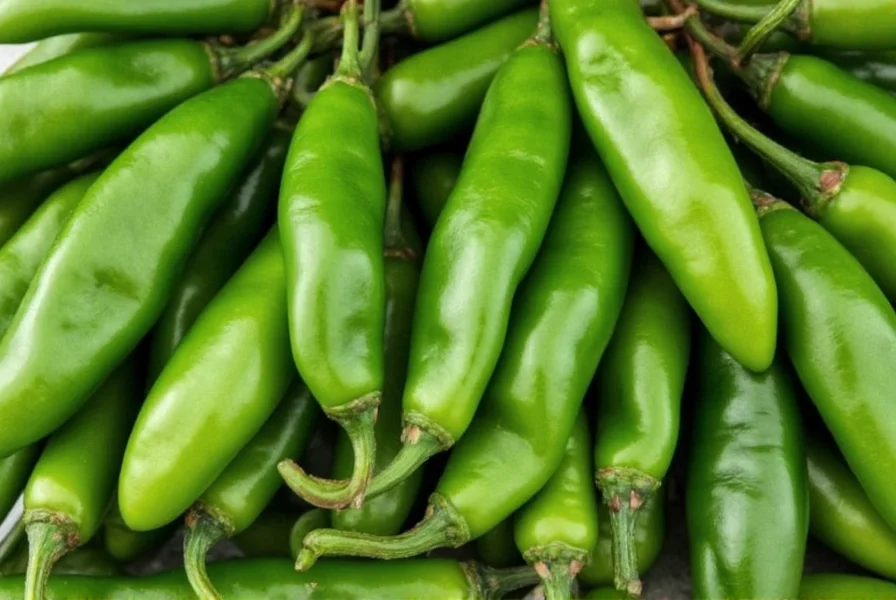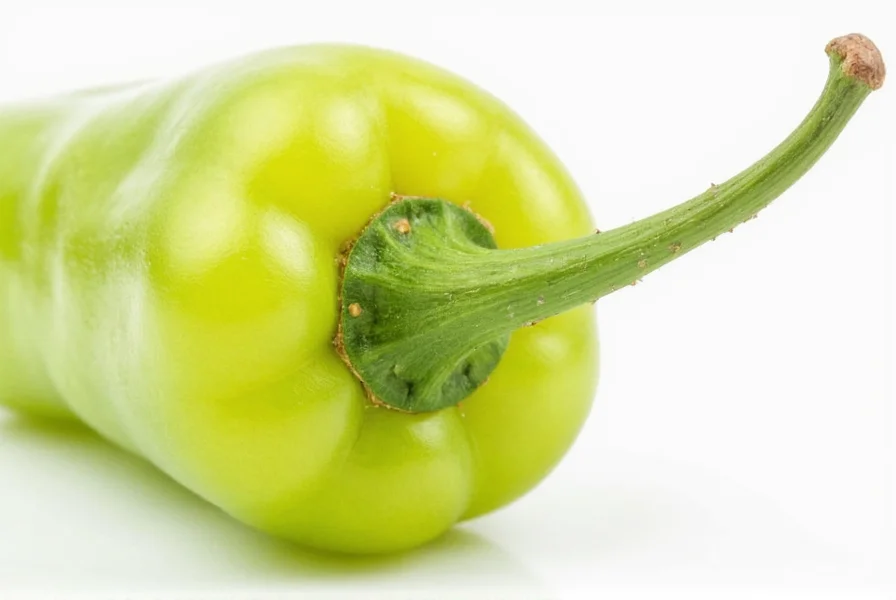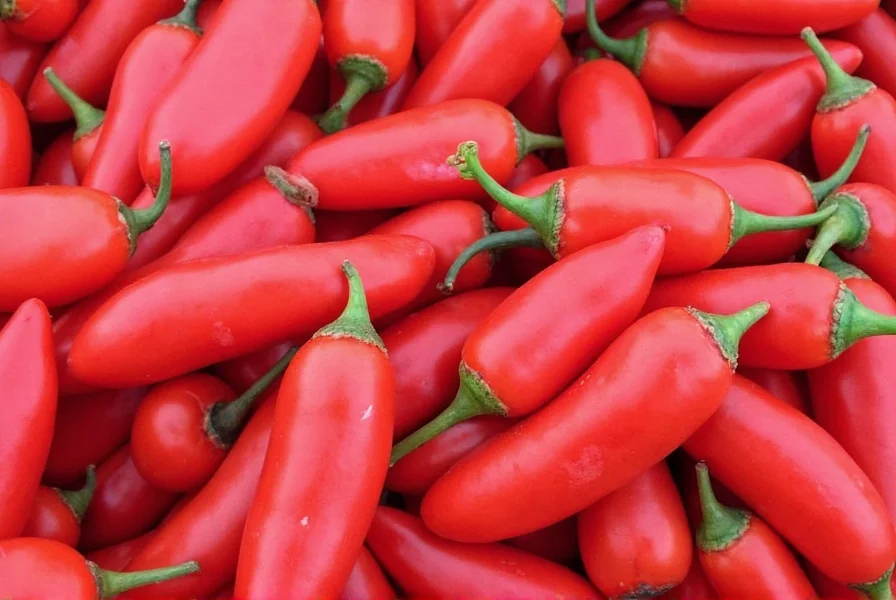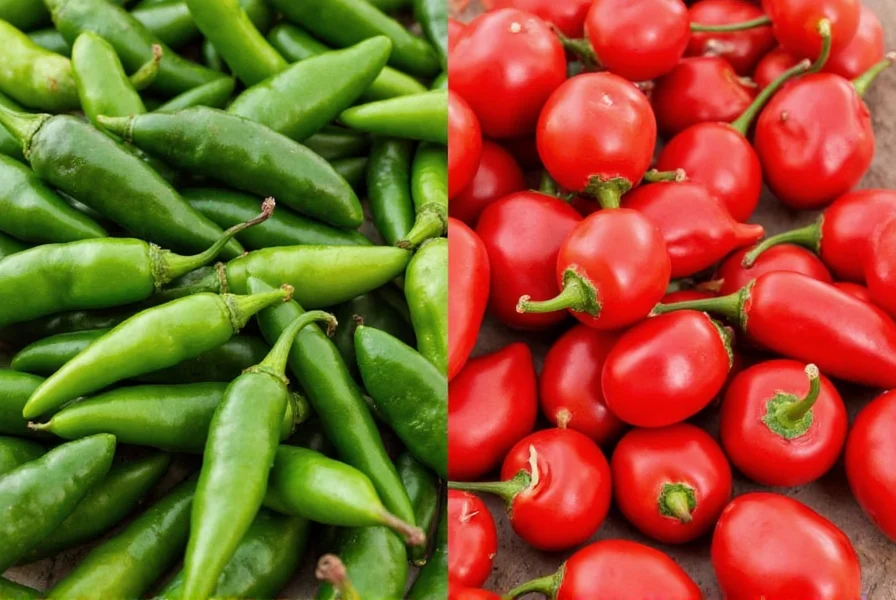Serrano peppers are small, slender chili peppers native to Mexico, known for their bright, grassy flavor and moderate to high heat level. With a Scoville rating of 10,000-23,000 SHU, they're significantly hotter than jalapeños but milder than habaneros. These versatile peppers are a staple in Mexican cuisine and can be used in salsas, sauces, and various dishes for added spice and flavor.

How Hot Is It, Really?
| Pepper | Heat Level (SHU) |
|---|---|
| Bell Pepper | 0 |
| Jalapeño | 2,500 – 8,000 |
| Serrano | 10,000 – 23,000 |
| Cayenne | 30,000 – 50,000 |
| Habanero | 100,000 – 350,000 |
So yes, they're significantly hotter than your average jalapeño but not quite in habanero territory. The heat level also varies depending on color: green serranos tend to be milder, while red, orange, or brown ones can bring the fire!
Taste Test: Flavor Beyond the Burn
If you think serranos are all about the heat, think again! These little guys have a crisp, grassy flavor with hints of citrus and a subtle sweetness. Unlike the jalapeño, which can sometimes feel a bit bland, serranos offer more depth and complexity, especially when roasted or pickled.

5 Unexpected Ways to Use Serrano Peppers
You don't need to be a chef to enjoy serrano peppers in everyday cooking. Here are five fun and flavorful ways to use them:
- Add to Guacamole: A diced serrano gives guac an extra zing without overpowering the avocado base.
- Make a Fire Vinegar: Steep sliced serranos in white vinegar for a few days and use it as a spicy condiment.
- Muddle Into Cocktails: Add a fresh twist to margaritas or Bloody Marys by muddling a bit of serrano into the mix.
- Stuffed Serranos: Hollow them out and stuff with cheese or meat, then bake until golden and gooey.
- Infused Oils: Infuse olive oil with serrano slices for a kick of heat in dressings and marinades.
Buying Guide: Picking the Best Serranos
When choosing serrano peppers at the store or market, here's what to look for:
- Firmness: Avoid soft or wrinkly peppers; go for firm, shiny skins.
- Color: Green ones are mild and great for salsas, while red, orange, or brown serranos are hotter and better for sauces or roasting.
- Size: Smaller serranos often pack more heat — so if you're looking for spice, smaller is better!
If you want to buy in bulk or find specialty products like dried serranos or serrano powder, here's a quick guide:
| Product Type | Description | Best For | Recommended Brand |
|---|---|---|---|
| Dried Serrano Peppers | Air-dried whole serranos with concentrated flavor | Soups, stews, rehydrated sauces | Tierra Mia Organics |
| Serrano Powder | Ground dried serrano peppers | Dry rubs, spice blends, seasoning mixes | Simply Organic |
| Pickled Serrano Peppers | Vinegar-brined serranos with tangy bite | Tacos, sandwiches, charcuterie boards | El Yucateco |

Can You Grow Your Own Serranos?
Want to grow your own chile serrano? Good news — they're relatively easy to cultivate indoors or outdoors!
- Climate: Warm weather (65°F–90°F) is ideal. They thrive in full sun.
- Soil: Well-draining soil rich in organic matter works best.
- Watering: Keep soil consistently moist but not soggy.
- Harvest Time: Around 80–100 days after planting.
They also do well in containers, making them perfect for balcony gardens or kitchen herb setups.
Serrano vs. Jalapeño: The Ultimate Face-Off
| Feature | Serrano | Jalapeño |
|---|---|---|
| Heat Level | High (10k–23k SHU) | Moderate (2.5k–8k SHU) |
| Flavor | Grassy, bright, slightly sweet | Mild, earthy, sometimes bland |
| Texture | Thin-walled, tender | Thicker skin, crunchy |
| Common Use | Salsas, hot sauces, pickling | Stuffed, grilled, canned |
Storage Secrets: Keep Them Fresh Longer
Want to keep your serranos tasting great and not turning to mush? Try these storage hacks:
- Refrigerator: Store unwashed serranos in a paper bag inside the crisper drawer — lasts up to 2 weeks.
- Freezing: Simply freeze whole peppers in a sealed bag. No need to peel or chop beforehand — just pull one out whenever you need it.
- Drying: Thread peppers onto a string and hang them in a warm, dry place. Alternatively, use a food dehydrator or oven on low heat.
- Oil or Vinegar: Preserve in oil or vinegar to infuse flavor and extend shelf life (store in fridge).

Spice Safety: Don't Let It Bite Back!
While delicious, handling serrano peppers can leave your hands burning — literally. Here's how to protect yourself:
- Wear gloves: Prevent capsaicin from irritating your skin.
- Avoid touching eyes: Capsaicin is super irritating to mucous membranes.
- Use milk, not water: If your mouth catches fire, drink dairy to neutralize the burn.
Frequently Asked Questions About Serrano Peppers
Is it "serrano" or "serano"? Which spelling is correct?
The correct spelling is "serrano" (with double "r"), named after the Sierra Madre mountains in Mexico. "Serano" is a common misspelling. The full name is "chile serrano" or "serrano pepper" in English.
How hot are serrano peppers compared to other common chilies?
Serrano peppers range from 10,000 to 23,000 Scoville Heat Units (SHU), making them 2-4 times hotter than jalapeños (2,500-8,000 SHU) but significantly milder than habaneros (100,000-350,000 SHU). Green serranos are typically milder than red or orange varieties.
Can I substitute serrano peppers for jalapeños in recipes?
Yes, but with caution. Since serranos are significantly hotter, use about half the amount of serrano compared to what a recipe calls for in jalapeños. If you want to maintain the same heat level, remove the seeds and membranes from the serranos before using.
How can I reduce the heat of serrano peppers when cooking?
To reduce heat: 1) Remove the white membranes and seeds (where most capsaicin is concentrated), 2) Soak sliced peppers in salt water for 15-30 minutes, 3) Cook them longer (heat breaks down capsaicin), or 4) Balance with dairy, sugar, or acid in your dish. Remember that cooking doesn't eliminate capsaicin - it just distributes it more evenly.
What are the health benefits of serrano peppers?
Like other chili peppers, serranos contain capsaicin which may boost metabolism and reduce inflammation. They're also rich in vitamin C (more than oranges by weight), vitamin A, and antioxidants. The heat can also help clear sinuses and may provide temporary pain relief when applied topically.
Why do my hands burn after handling serrano peppers, and how can I prevent it?
The burning sensation is caused by capsaicin, the compound that makes peppers hot. To prevent this: wear gloves when handling, avoid touching your face, and wash hands thoroughly with soap afterward. If you do get burned, use milk, yogurt, or oil (not water) to neutralize the capsaicin on your skin.
Final Thoughts
Whether you're a seasoned cook or just starting with spicy foods, serrano peppers offer a perfect balance of heat and flavor that can elevate your dishes. From salsas to cocktails, these peppers are a versatile addition to any kitchen. For best results, always handle them with care and respect their heat potential to fully enjoy their culinary benefits.










 浙公网安备
33010002000092号
浙公网安备
33010002000092号 浙B2-20120091-4
浙B2-20120091-4